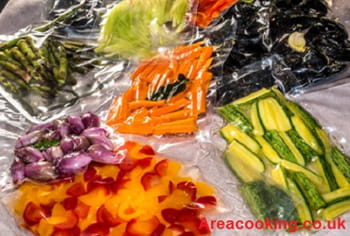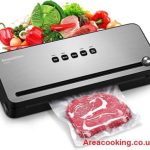As an Amazon Associate, I earn from qualifying purchases.

How to vacuum seal vegetables for storage and use. This article shows you how to seal vegetables.
Why Vacuum Sealing Vegetables is Important?
Vegetables are highly perishable and tend to spoil quickly, especially when they come into contact with moisture, air, and light. By vacuum sealing your vegetables, you eliminate the air and reduce the amount of moisture that can get in, preserving the texture, flavor, and color of your veggies.
Types of Vacuum Sealers
There are three main types of vacuum sealers: handheld vacuum sealers, external vacuum sealers, and chamber vacuum sealers.
Handheld Vacuum Sealers
Handheld vacuum sealers are the most affordable and portable type of vacuum sealer. They are ideal for small-scale vacuum sealing tasks, such as sealing vegetables in small portions. Handheld vacuum sealers work by attaching a special nozzle to the bag and manually removing the air.
External Vacuum Sealers
External vacuum sealers are slightly more expensive than handheld vacuum sealers but are more efficient. They are ideal for home use and can be used to vacuum seal vegetables in larger portions. External vacuum sealers work by creating a vacuum outside the bag, pulling the air out through a one-way valve.
Chamber Vacuum Sealers
Chamber vacuum sealers are the most expensive and most efficient type of vacuum sealer. They are ideal for commercial use or for those who need to vacuum seal large quantities of vegetables. Chamber vacuum sealers work by placing the bag inside a chamber, where the air is removed from both the bag and the chamber simultaneously.
Contents
How to Vacuum Seal Vegetables

Now that you understand the importance of vacuum sealing vegetables and the types of vacuum sealers available, let’s look at the steps involved in vacuum sealing vegetables.
Step 1: Prepare the Vegetables
Before vacuum sealing your vegetables, you need to clean and dry them thoroughly. Ensure that you remove any dirt or debris from the vegetables to prevent the growth of bacteria.
Step 2: Choose the Right Bag
When vacuum sealing vegetables, it is crucial to choose the right bag. The bag should be made of a material that is safe for food storage and has a one-way valve. You can choose between pre-cut bags or rolls of bag material that can be cut to size.
Step 3: Fill the Bag

Fill the bag with the vegetables, leaving enough space at the top to create a good seal. Do not overfill the bag as this can prevent the bag from sealing correctly.
Step 4: Vacuum Seal the Bag
Attach the vacuum sealer’s nozzle or place the bag in the sealer, depending on the type of vacuum sealer you are using. Start the vacuum sealer and allow it to remove the air from the bag. Once the air is removed, the bag’s valve will close automatically, and the sealer will start sealing the bag.
Step 5: Store the Bag
Once the bag is vacuum sealed, it is ready for storage. Store the bag in a cool, dry place away from sunlight. The vacuum-sealed bag will keep your vegetables fresh for up to five times longer than non-vacuum-sealed vegetables.
Tips for Vacuum Sealing Vegetables

- Always use high-quality vacuum sealer bags and ensure that they are compatible with your vacuum sealer.
- Do not overfill the bags as this can prevent them from sealing correctly.
- When storing vegetables, label the bags with the date of storage to keep track of their freshness.
- If you are freezing vacuum-sealed vegetables, blanch them first to prevent freezer burn.
- Always clean your vacuum sealer after each use to prevent the growth of bacteria.
Frequently Asked Questions (FAQs)
Can you vacuum seal fresh vegetables?
Yes, you can vacuum seal fresh vegetables to extend their shelf life.
How long can vacuum-sealed vegetables last?
Vacuum-sealed vegetables can last up to five times longer than non-vacuum-sealed vegetables.
Can you vacuum seal cooked vegetables?
Yes, you can vacuum seal cooked vegetables, but they will not last as long as fresh vegetables.
Can you vacuum seal leafy greens?
Yes, you can vacuum seal leafy greens, but they may become slightly wilted.
Do you need a special vacuum sealer to vacuum seal vegetables?
No, you do not need a special vacuum sealer to vacuum seal vegetables. Any vacuum sealer with a one-way valve will work.
Conclusion
Vacuum sealing vegetables is an effective way to preserve their freshness and extend their shelf life. By following the steps outlined in this guide and using high-quality vacuum sealer bags, you can keep your vegetables fresh for a longer time. With a little practice, vacuum sealing vegetables can become a simple and convenient way to store your favorite veggies.





